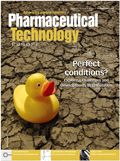Establishing Endpoints
Pharmaceutical Technology Europe
The unit selected for wet granulation, whether it be a high shear mixer or a fluidised bed, has a marked impact on granule properties.
The unit selected for wet granulation, whether it be a high shear mixer or a fluidised bed, has a marked impact on granule properties. In routine operation, however, the desired outcomes are achieved by manipulating just a small number of operational variables. High shear mixing is the most widely used processing method and key operational variables include: the amount of granulation solution added, rate of addition, impeller speed and processing time.
Endpoint determination poses problems for two main reasons. Firstly, the granules manufactured are not usually the finished product and the manufacturer can only reliably assess granule quality by working them up, typically into a finished tablet. This means that the iterative process of changing granulation conditions — seeing whether the change is beneficial, and then making further changes — can be a lengthy one.

Tim Freeman
Secondly, granulation processes, as with other processes involving mixing, tend not to scale easily because conditions that produce good quality granulates in the lab are not necessarily optimal for pilot studies or commercial manufacture. At each new scale therefore, the optimal endpoint for the process must be re-established.
One traditional way for an experienced operator to detect endpoint is to open the granulator, manually extract a sample, compress it between their fingers and evaluate it by eye, but this is clearly a highly subjective technique!
A more scientific approach is to measure particle size. This can be successful where size is the defining characteristic of the granule; however, other parameters, such as shape or density, may also be important. Where this is the case, size measurement alone may be inadequate.
A common practice with commercial scale, high shear granulators is to monitor the power drawn by the impeller. As the granulation nears its endpoint, power consumption rises steeply because the granulating mass becomes denser, more adhesive and harder to move. With experience, the shape of the power consumption curve may become somewhat correlated with a defined endpoint, thus enabling its detection — although with varying degrees of accuracy.
Recent research has shown that Basic Flowability Energy (BFE) is a useful parameter with which to track wet granulation processes and define an endpoint. There are parallels here with monitoring the power drawn by the impeller because BFE is a measure of the energy required to maintain flow in a sample of powder or granulate. Measuring BFE, however, is far more precise because of the high reproducibility achievable with powder rheometry.
BFE is a dynamic powder property measured using a powder rheometer. As granulation proceeds, the powder properties remain relatively unchanged up to the transition point from wet mass to granules, a transition that essentially marks the end of the process. At this point, BFE rises sharply. Dense, stiff granules adhere more strongly to one another than the finer particles of the wet mass and so the bed begins to exert considerable resistance to flow. Because the rise in BFE is sharp, the parameter is sensitive to slight changes in the exact region of interest for endpoint detection, making it a precise measure for control.
Alternatively, it has also been shown that changes in permeability track the progression towards granules. As granulation proceeds and granules grow in size, permeability increases steadily. Because this parameter changes linearly with increasing water content, however, it is less sensitive than BFE for endpoint detection.
Room for further innovation
Given the way that manufacturing is changing within the industry, real-time, on- and/or in-line instrumentation is becoming increasingly preferred, where its application is feasible. With respect to granulation, on-line NIR detection for moisture content measurement and on- or in-line particle size analysis are both commercially available and applied. As BFE has proven to be a particularly relevant and sensitive tool for monitoring granulation applications, its evolution as an on-line as opposed to at-line method would be a welcome innovation.
As manufacturers increasingly choose to use BFE as part of the specification for granule properties, it is inevitable that more published data correlating BFE with tabletting performance will emerge.
The benefits of accurate endpoint determination
As discussed earlier, if we define endpoint by saying "add x litres of granulation solution and process at an impeller speed of y rpm for z minutes", then each new scale presents a new optimisation challenge because the values of x, y and z will depend on the scale of the granulation process. If, on the other hand, we can define endpoint in terms of a granule property independent of scale, then moving from development to full production is easier. Considering the measurement of granule flow properties, at each stage we are targeting the same BFE as granules made at a small scale that made ideal tablets, rather than using conditions that work only at that smaller scale. This iterative process to reach acceptable processing conditions is therefore accelerated at each scale.
Efficient endpoint detection is, of course, essential for consistent product quality. More than that though, it maximises equipment utilisation, where granulating for just long enough to meet a specification ensures that a unit is not tied up unproductively.
Tim Freeman is Director of Operations at Freeman Technology.
This article is part of a special feature on granulation that was published in the March issue of PTE Digital, available at www.pharmtech.com/ptedigital0311

Drug Solutions Podcast: A Closer Look at mRNA in Oncology and Vaccines
April 30th 2024In this episode fo the Drug Solutions Podcast, etherna’s vice-president of Technology and Innovation, Stefaan De Koker, discusses the merits and challenges of using mRNA as the foundation for therapeutics in oncology as well as for vaccines.